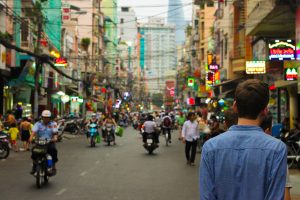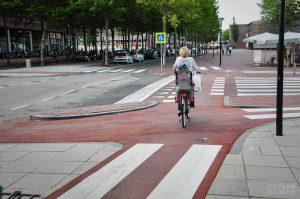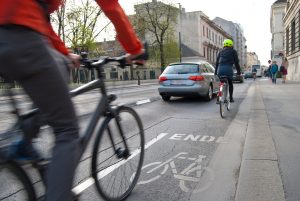
At any moment, our field of view contains objects that are totally irrelevant to the task that we are currently performing. For example, if we cycle through a busy shopping street on the way to a party, the shop windows and the posters are totally irrelevant. Nevertheless, our retina registers the entire image and transmits it to the primary visual cortex. Because our brain has a limited capacity, it is impossible to process that image in all its aspects (which objects, what do they mean, how do they move, …). The brain therefore has a mechanism that enables it to process only the relevant aspects of that image, and therefore to perceive it better (i.e., faster and more accurately). This mechanism is called “selective attention”, and here the adjective “selectively” indicates that this improved perception is specific to those relevant aspects.
![By https://www.flickr.com/people/peepeehead/ [CC BY 2.0 (https://creativecommons.org/licenses/by/2.0)], via Wikimedia Commons](https://ikblijffietsen.nl/wp-content/uploads/2018/07/Brass_Bicycle_Bell-300x225.jpg)
- spatial attention
- temporal attention
- object-based attention
Spatial attention realises a better perception of stimuli at a certain location (eg, left, right, front, back), temporal attention to stimuli in a certain time period (eg, within 3 seconds), and object-based attention to stimuli of a certain category (e.g., cars, bicycles, poles). These three types of selective attention are all based on a prediction of the relevant sensory information, and this prediction is based on so-called “cues”. Cues are stimuli that indicate where (for spatial attention) and when (for temporal attention) a relevant other stimulus will appear, as well as what kind of stimulus that will be (for object-based attention). The best known cue for cyclists is the bicycle bell, and this can be a spatial, a temporal, or an object-based cue. For example, if you are riding a bike path, and you hear behind you the sound of a bicycle bell, then you know that within a few seconds (the temporal aspect) on your left (the spatial aspect) another cyclist (the object-based aspect ) will appear.

Most cues are much more implicit than the bicycle bell, and you learn them from experience. For example, if your cycle path crosses an ordinary road, you focus your attention to the left and to the right to notice any crossing traffic. As long as your bicycle path does not cross another road, you just have to focus your attention forwards. A crossing road then is a cue to direct your attention to the left and to the right. And an example of a temporal cue is the sound of a car approaching you from behind: both the strength and the pitch of this sound changes depending on your distance to the car, and this directs your attention. (If you want to know more about the physics behind that change in pitch, then this is a good starting point.)

Improved perception as a result of selective attention thus depends on the possibility of making a prediction about the place/time/category of an object. A minimum condition for selective attention is therefore the ability to perceive predictive cues. This means that our attention should be focused on our environment, and not on internal processes such as preparing a movement or creating a shopping list. This is especially important in situations that are potentially dangerous for a cyclist, such as in a busy environment with a lot of motorised traffic. If, on the other hand, you drive on a bike path on your own, it can not hurt so much if you let your thoughts go.
Selective attention is a function of the prefrontal cortex, just like motor preparation. Selective attention and motor preparation are also very similar: selective attention pertains to the observation of future objects, and motor preparation pertains to future movements (eg, changing direction). In practice, it is difficult to distinguish between selective attention and motor preparation. This is because perception and movement are so closely linked: the perception of an object almost always results in a movement. For example, if a cyclist before us suddenly slows down, then we will either dodge or slow down as well. And if a car crosses our cycle path (not giving priority), we will immediately brake. Thus, selective attention to a specific object at a specific place and time often goes hand in hand with the preparation of a certain movement.